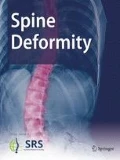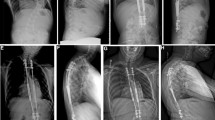Abstract
Purpose
The purpose of this study was to determine the relationship between pre-operative scoliosis flexibility and post-operative outcomes, including curve correction and complications, for patients who have been treated with growth friendly surgery (GFS) for early onset scoliosis (EOS).
Methods
The study was conducted as a retrospective review of prospectively collected data from an international, multicenter, EOS database. EOS patients with pre-operative flexibility radiographs (traction or bending) were identified. Pre-operative flexibility and immediate post-operative correction were calculated for each patient. Post-operative complications were recorded at final follow-up. Pearson correlations were determined for flexibility vs correction for all patients and were compared between etiologies and between device types (MCGR, TGR, VEPTR).
Results
107 patients (14 congenital, 43 neuromuscular, 31 syndromic, 19 idiopathic) with mean age 7.1 years at index surgery were identified. Mean pre-operative scoliosis was 77°. Mean flexibility of 36% was not significantly different between etiologies. Mean immediate post-operative scoliosis was 46° (p < 0.001 vs. pre-operative) with mean correction of 38%. Correction rate was not significantly different between etiologies; however, correction rate was different between device types (MCGR 45%, TGR 40%, VEPTR 14%; p = < 0.001). Pearson correlation for flexibility vs correction was fair (r = 0.37, p < 0.001). This correlation was observed for idiopathic (r = 0.53, p = 0.020) and neuromuscular (r = 0.46, p = 0.0020) scoliosis, but not for congenital or syndromic scoliosis. At a mean of 6.1 year follow-up (minimum 2 years to 15.5 years), 60 of 81patients (74%) experienced at least one complication. Odds ratio for developing a complication was 3.00 (1.03–8.76) for patients with pre-operative flexibility < 45% (p < 0.05).
Conclusions
As lower pre-operative flexibility was associated with less scoliosis correction and with a higher risk of post-operative complications, curve flexibility should be considered when deciding upon the timing of growth friendly surgery.
Level of evidence
Level III—retrospective comparative study.



Similar content being viewed by others
Availability of data
Registry data is available to member institutions. Measurements and analysis done at the IWK Health Centre are on a password protected server. Access may be arranged through application to the REB.
Code availability
Statistical analysis was conducted using Excel version 2002 (Microsoft Corporation, Redmond, Washington, USA) and R version 4.0.2. (R Core Team, Vienna, Austria).
References
El-Hawary R, Akbarnia BA (2015) Early onset scoliosis—time for consensus. Spine Deform 3:105–106. https://doi.org/10.1016/j.jspd.2015.01.003
Skaggs DL, Guillaume T, El-Hawary R et al (2015) Early onset scoliosis consensus statement, SRS Growing Spine Committee, 2015. Spine Deform 3:107. https://doi.org/10.1016/j.jspd.2015.01.002
El-Hawary R, Chukwunyerenwa C (2014) Update on evaluation and treatment of scoliosis. Pediatr Clin N Am 61:1223–1241. https://doi.org/10.1016/j.pcl.2014.08.007
Williams BA, Matsumoto H, McCalla DJ et al (2014) Development and initial validation of the Classification of Early-Onset Scoliosis (C-EOS). J Bone Jt Surg Am 96:1359–1367. https://doi.org/10.2106/JBJS.M.00253
Akbarnia BA (2007) Management themes in early onset scoliosis. J Bone Jt Surg 89:42–54. https://doi.org/10.2106/JBJS.F.01256
Yang S, Andras LM, Redding GJ, Skaggs DL (2016) Early-onset scoliosis: a review of history, current treatment, and future directions. Pediatrics 137(1):e20150709. https://doi.org/10.1542/peds.2015-0709
Helenius IJ (2018) Treatment strategies for early-onset scoliosis. EFORT Open Rev 3:287–293. https://doi.org/10.1302/2058-5241.3.170051
Dodwell ER, Pathy R, Widmann RF et al (2018) Reliability of the modified Clavien-Dindo-Sink complication classification system in pediatric orthopaedic surgery. JBJS Open Access 3:e0020. https://doi.org/10.2106/jbjs.oa.18.00020
Smith JT, Johnston C, Skaggs D et al (2015) A new classification system to report complications in growing spine surgery: a multicenter consensus study. J Pediatr Orthop 35:798–803. https://doi.org/10.1097/BPO.0000000000000386
Lucas G, Bollini G, Jouve J-L et al (2013) Complications in pediatric spine surgery using the vertical expandable prosthetic titanium rib. Spine (Phila Pa 1976) 38:E1589–E1599. https://doi.org/10.1097/BRS.0000000000000014
Studer D, Hasler C-C (2020) Long term outcome of vertical expandable prosthetic titanium rib treatment in children with early onset scoliosis. Ann Transl Med 8:25–25. https://doi.org/10.21037/atm.2019.09.158
El-Hawary R, Kadhim M, Vitale M et al (2017) VEPTR implantation to treat children with early-onset scoliosis without rib abnormalities: early results from a prospective multicenter study. J Pediatr Orthop 37:e599–e605. https://doi.org/10.1097/BPO.0000000000000943
El-Hawary R, Morash K, Kadhim M et al (2020) VEPTR treatment of early onset scoliosis in children without rib abnormalities: long-term results of a prospective, multicenter study. J Pediatr Orthop 40:e406–e412. https://doi.org/10.1097/BPO.0000000000001454
Thakar C, Kieser DC, Mardare M et al (2018) Systematic review of the complications associated with magnetically controlled growing rods for the treatment of early onset scoliosis. Eur Spine J 27:2062–2071. https://doi.org/10.1007/s00586-018-5590-4
Kwan KYH, Alanay A, Yazici M et al (2017) Unplanned reoperations in magnetically controlled growing rod surgery for early onset scoliosis with a minimum of two-year follow-up. Spine (Phila Pa 1976) 42:E1410–E1414. https://doi.org/10.1097/BRS.0000000000002297
Bess S, Akbarnia BA, Thompson GH et al (2010) Complications of growing-rod treatment for early-onset scoliosis: analysis of one hundred and forty patients. J Bone Jt Surg Am 92:2533–2543. https://doi.org/10.2106/JBJS.I.01471
El-Hawary R, Sturm P, Cahill P et al (2017) What is the risk of developing proximal junctional kyphosis during growth friendly treatments for early-onset scoliosis? J Pediatr Orthop 37:86–91. https://doi.org/10.1097/BPO.0000000000000599
Gomez JA, Kubat O, Tovar Castro MA et al (2020) The effect of spinopelvic parameters on the development of proximal junctional kyphosis in early onset: mean 4.5-year follow-up. J Pediatr Orthop 40:261–266. https://doi.org/10.1097/BPO.0000000000001516
He C, Wong M-S (2018) Spinal flexibility assessment on the patients with adolescent idiopathic scoliosis. Spine (Phila Pa 1976) 43:E250–E258. https://doi.org/10.1097/BRS.0000000000002276
Tambe AD, Panikkar SJ, Millner PA et al (2018) Current concepts in the surgical management of adolescent idiopathic scoliosis. Bone Jt J 100-B:415–424. https://doi.org/10.1302/0301-620X.100B4.BJJ-2017-0846.R2
Cheung WY, Lenke LG, Luk KDK (2010) Prediction of scoliosis correction with thoracic segmental pedicle screw constructs using fulcrum bending radiographs. Spine (Phila Pa 1976) 35:557–561. https://doi.org/10.1097/BRS.0b013e3181b9cfa9
Dobbs MB, Lenke LG, Walton T et al (2004) Can we predict the ultimate lumbar curve in adolescent idiopathic scoliosis patients undergoing a selective fusion with undercorrection of the thoracic curve? Spine (Phila Pa 1976) 29:277–285. https://doi.org/10.1097/01.BRS.0000106488.51299.75
Funding
No funding was received for this study.
Author information
Authors and Affiliations
Consortia
Contributions
RB, KM, AM, BY, LA, PS, PS, GT, Pediatric Spine Study Group, RE-H: design or the acquisition, analysis, or interpretation of data, drafted the work or revised it critically, approved, accountable.
Corresponding author
Ethics declarations
Conflict of interest
Riley Bowker has nothing to disclose. Kevin Morash has nothing to disclose. Amir Mishreky reports personal fees from Dalhousie University Faculty of Medicine Summer Student Research Program, during the conduct of the study. Burt Yaszay reports reports grants and personal fees from Stryker, grants and personal fees from Depuy Synthes, grants and personal fees from Nuvasive, personal fees from Biogen, personal fees from Medtronic, personal fees from Globus, personal fees from Orthopediatrics, outside the submitted work. Lindsay Andras reports personal fees from Zimmer Biomet, other from Eli Lilly, other from Journal of Pediatric Orthopaedics, personal fees from Medtronic, personal fees from Nuvasive, non-financial support from Orthobullets, other from Pediatric Orthopaedic Society of North America, other from Scoliosis Research Society, outside the submitted work. Peter Sturm reports personal fees from Nuvasive, personal fees from Depuy Synthes Spine, outside the submitted work. Paul Sponseller has nothing to disclose. George Thompson reports personal fees from Shriners Hospitals for Children, personal fees from OrthoPediatrics, personal fees from Wolters Kluwer, personal fees from Broadwater, other from Scoliosis Research Society, other from Nuvasive, outside the submitted work. Pediatric Spine Study Group reports grants from Pediatric Orthopaedic Society of North America, grants from Food and Drug Administration, grants from NuVasive, grants from DePuy Synthes Spine, grants from Children’s Spine Foundation, and grants from Growing Spine Foundation. Ron El-Hawary reports grants and personal fees from Depuy Synthes Spine, grants and personal fees from Medtronic Spine, personal fees and other from Orthopediatrics, other from Pediatric Spine Foundation, other from Scoliosis Research Society, personal fees from Wishbone Medical, personal fees from Globus Medical, outside the submitted work.
Ethical approval
This work is a sub-study of the Pediatric Spine Study Group Registry which was approved by the Research Ethics Board at the IWK Health Centre (#1002256) in accordance with the ethical standards outlined in the Tri-Council Policy Statement and the 1964 Declaration of Helsinki and its later amendments.
Consent to participate
All research participants or their legal guardians provided written consent to be a part of the registry and have the data collected be used in ongoing research on scoliosis.
Consent for publication
Not applicable.
Additional information
Publisher's Note
Springer Nature remains neutral with regard to jurisdictional claims in published maps and institutional affiliations.
Supplementary Information
Below is the link to the electronic supplementary material.
Rights and permissions
About this article
Cite this article
Bowker, R., Morash, K., Mishreky, A. et al. Scoliosis flexibility correlates with post-operative outcomes following growth friendly surgery. Spine Deform 10, 933–941 (2022). https://doi.org/10.1007/s43390-022-00481-0
Received:
Accepted:
Published:
Issue Date:
DOI: https://doi.org/10.1007/s43390-022-00481-0



